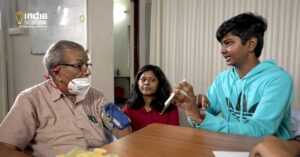Play, Learn, Grow, Repeat: A Peak Inside India’s Innovative, DIY, Sustainable Playgrounds
Anthill Creations, which transforms “spaces into interactive and sustainable playgrounds by upcycling waste materials like tyres, oil and cable drums” has built around 380 playgrounds for children across 22 states.
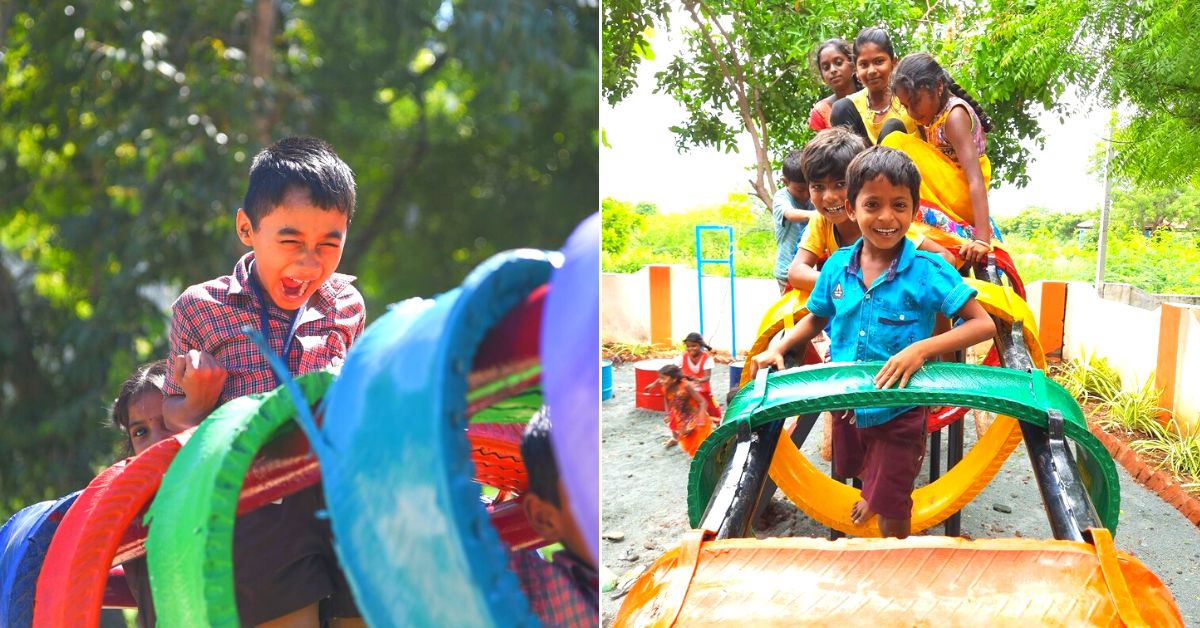
This article was published in collaboration with EkStep Foundation.
When Pooja Rai was a student of architecture at the Indian Institute of Technology (IIT), Kharagpur, she would volunteer at Disha Seema Care Centre, a school for underprivileged children located on campus. During one visit, she observed a few girls playing on broken cement pipes while some construction work was going on nearby.
“It was extremely unsafe because you had wires coming out of the pipes and there were broken pieces of cement lying around. I also saw some boys at school trying to play a game of badminton with their slippers. Even though there was so much joy in that space, it just made me think that these children don’t even have access to something as simple as a playground. Talking to my friend that evening, we discussed how we could use all the design knowledge that we learned to build a playground for these kids,” says Rai, speaking to The Better India.
Given that Pooja and her batchmates were students, they didn’t have a lot of money. Instead of building a conventional playground with a jungle gym, merry go round and slides, they got innovative, brought a few tires together, and built a different kind of playground.
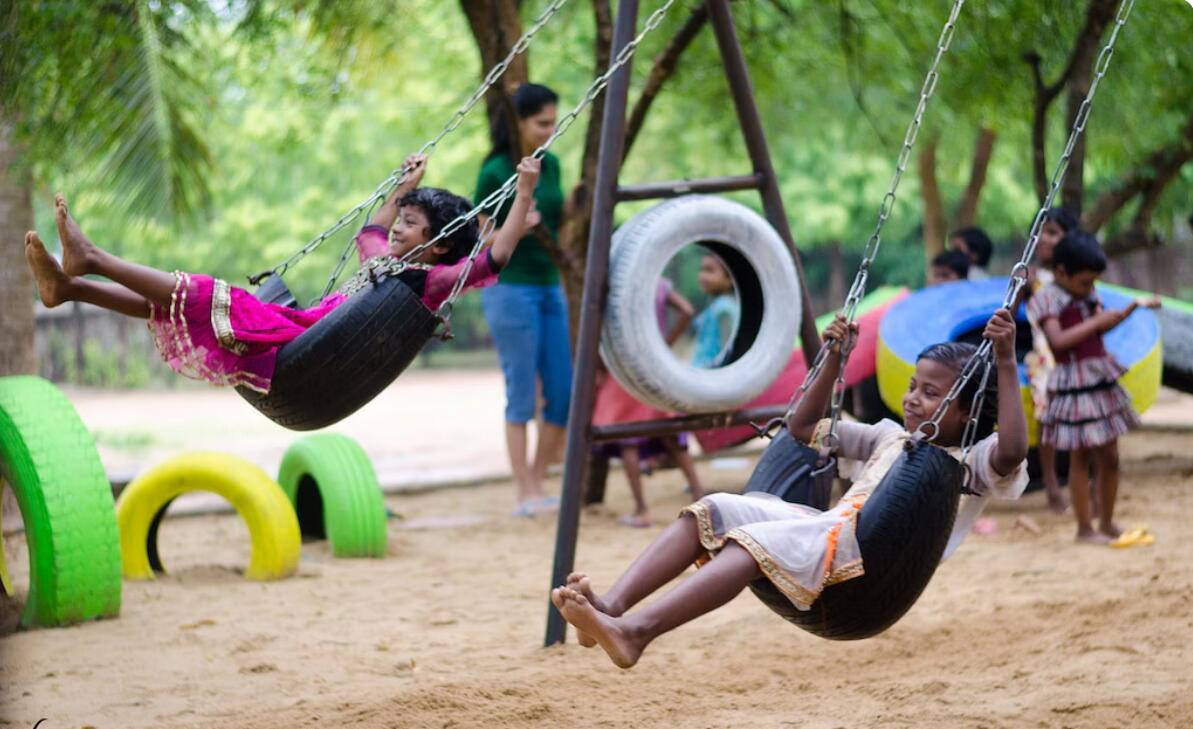
A ‘DIY’ playground
“Initially, we struggled to collect tires, but we got lucky after reaching out to a few companies. Michelin, a global tyre manufacturer, sponsored the very first playground we built. They sent us used tires, with which we built swings and other play elements for children. They also sponsored a part of the project, while the rest of the funding came from our college alumni. We built our first playground in 2015 and it was completely DIY (‘do it yourself’),” she recalls.
What Rai and her batchmates built here was a low-cost (barely Rs 20,000) and sustainable playground for underprivileged children. According to Rai, mass produced recreational equipment for building a playground at the time would typically cost about Rs 2 lakh. What followed was a lot of media coverage and inquiries from all around the country to build similar structures.
Fast forward to January 2017, Rai and her friends quit their jobs full time and established a Bengaluru-based non-profit called Anthill Creations, which “transforms spaces into interactive and sustainable playgrounds by upcycling waste materials like tyres, oil and cable drums.” So far, they have built around 380 low-cost and sustainable playgrounds for children across 22 states including Karnataka, Maharashtra, Delhi, Odisha, Meghalaya, Tripura, amongst others.
But why are playgrounds important for children in the first place? Educationists note that at the heart of early childhood care and education (ECCE) is play-based learning.
Why play-based learning matters
“Based on science and what we know, and from a lot of experience, play is an important way for the child to learn. In this context, it is not just ‘playing’ as we know it. It includes singing songs, conversations, stories, music, puzzles, dancing, etc. It is what the child does naturally, or as we say, ‘play is child’s work’. When a child is playing, they are learning,” said Shankar Maruwada, CEO and co-founder of EkStep Foundation and member, National Steering Committee for the National Curriculum Frameworks (NCF), in an earlier interaction with The Better India.
This line of thinking has been emphasised by policymakers in India with the New Education Policy (NEP) 2020 and the National Curriculum Framework for School Education (NCF) 2023.
(You can read more about play-based learning here and here.)
While there are different modes of play, a playground presents one of the key platforms where a child can engage in play-based learning for cognitive and behavioural development. But nearly half of all public-funded schools in India don’t have playgrounds, notes government data.
According to the Unified District Information System for Education (UDISE) 2017-18 survey, less than 57% of schools have playgrounds. In states like Odisha and Jammu and Kashmir, less than 30% of schools have playgrounds. Other surveys indicate that even major cities don’t have enough playgrounds. Take Bengaluru, for example.
According to Janaagraha, a Bengaluru-based think-tank, “With a population of 12 million (unofficial estimate, 8.4 million as per 2011 census) and an area of 709 sq.km, the city of Bengaluru has only 19.31 sq.km dedicated towards open spaces like parks and playgrounds. This translates to 2.2 sq.m of open space per person, which is significantly short of the recommended 10-12 sq.m by the URDPFI (Urban and Regional Development Plans Formulation and Implementation*) guidelines set by the Ministry of Urban Development (MoUD), India.” What’s worse, only 39% of playgrounds in the city have playing equipment and facilities.
Srikanth Viswanathan, CEO at Janaagraha Centre for Citizenship and Democracy, notes that although the survey was taken in 2017, “things haven’t changed much since”.
This is an unfortunate reality despite the fact that the Right of Children to Free and Compulsory Education Act, 2009 (RTE) legislated by Parliament mandates that all school-going children between the ages of 6 and 14 should be guaranteed access to playgrounds.
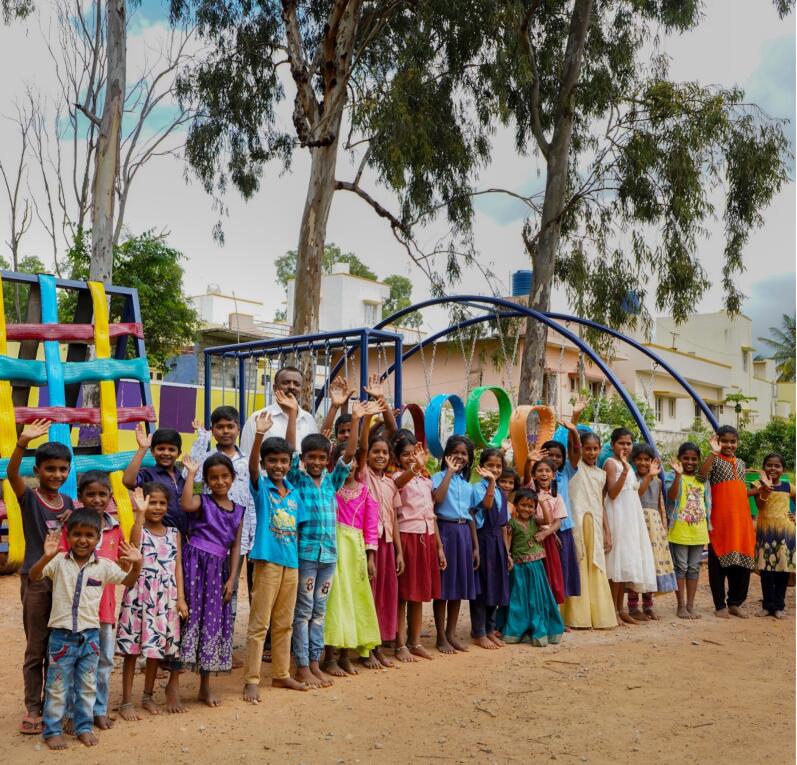
Accessibility for all
What does it take to build a playground? Speaking to The Better India, Rai begins with first principles. “The basic principle we follow is that where there is a need for a playground and people cannot afford it, we are happy to build these structures in those areas,” she says.
“What we have seen in the last few years is that even if we build one or two playgrounds in the area, it motivates other people in the surrounding areas and creates awareness around the importance of play and how much good it can do. The playground is also usually shared by nearby communities or schools. It’s not limited to the one school where we built it,” she adds.
Thus far, Anthill Creations has built playgrounds in major cities like Bengaluru, Delhi and Mumbai to the remote corners of states like Meghalaya and Tripura. Here’s an example of how they built playgrounds for four government schools in rural Meghalaya.
Speaking to The Better India, Abhishek Gowda, the sub-divisional officer (civil) of Dadenggre [subdivision] in West Garo Hills district, Meghalaya, recalls the work Anthill did.
“In January 2023, Anthill Creations approached me to facilitate the site selection process for these playgrounds under their project titled ‘Bring Back Play by Making it Accessible to All’. Their team visited around 10 rural schools in my sub-division, and finalised on four where they would build playgrounds. By the end of March, the Anthill team began building these playgrounds using old rubber tires and other scrap material. You had see-saws, elephant-shaped play elements and swings made of scrap rubber tires,” says Gowda.
After constructing these playgrounds, the Anthill team conducted an extensive quality check process to ensure that these structures are safe for children to use.
“Once the quality check was done, they handed over the playgrounds to their respective schools and communities. By the end of April, these playgrounds were built and ready to use. Today, children are actually utilising these playgrounds with a lot of enthusiasm and happiness. These playgrounds have also transformed the environment in these schools,” he adds.
Gowda and his administration’s task in building these playgrounds was simple. They provided any administrative and logistical support the Anthill team needed. Funding for this project came from the National Payments Corporation of India (NPCI)’s CSR fund and all the work of actually selecting the sites and building these playgrounds was done by the Anthill team.
“Although the main objective is to develop play-based learning infrastructure for early childhood development, we’ve seen improvements in school enrolment numbers and reduction in dropouts. As a result of these colourful playgrounds, the atmosphere in these schools feel a lot more welcoming to children,” notes Gowda.
Around 80% of the playgrounds Anthill has built are in government schools, but they also build them in public places. “We’ve built a lot of public park playgrounds in Bengaluru like in Agara Lake, for example. We also partnered with another organisation called Recity to start building playgrounds in tourist hotspots Nainital and Darjeeling so that there’s more awareness around recycling. Those are places where a lot of people visit, so they generate a lot of waste,” says Rai.
“But it’s challenging for us to work in public spaces because you’d have to work with multiple authorities. It’s difficult to get permission from all stakeholders at the same time,” she adds.
Schools, however, are where most children are present. “And typically, what I have seen in government schools is that they keep their playgrounds open to neighbouring children. So, it’s not really just the school children who are playing in those playgrounds,” says Rai.
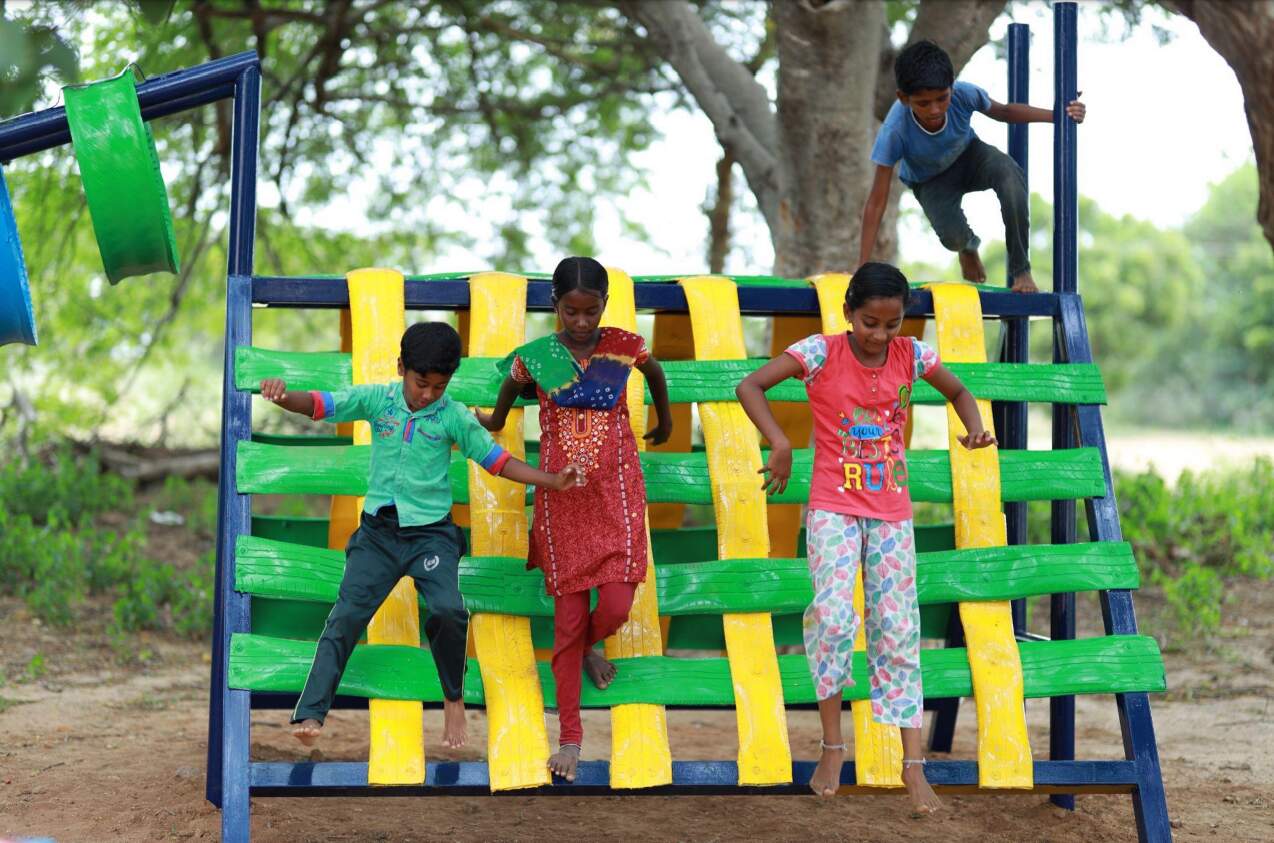
From elephants and horses to rockets on the playground
When Rai and her colleagues started building playgrounds, they didn’t want to build the typical elements that already exist like a jungle gym, see-saw, merry go round, etc.
“The correct way to go about any design is asking the user what they want to do. In the early days, we would talk to the children. Some of the very first designs that we developed were thanks to children. We used to go to these schools in Bengaluru, conduct activities and play games with them. Children used to come up with amazing ideas. They would want a slide from their classroom to the playground or a water fountain coming out of a slide. We did not exactly translate what they said but we got a sense of what they wanted in a playground,” she says.
Some of the play elements you see on playgrounds built by Anthill like octopus, elephants or horses came from children. Other children wanted a rocket in their playground.
“We tried to incorporate some of those major structural designs, but also keep activities in mind when we were designing those final elements. It took a lot of iterations. Not all of our design elements became successful in the first go, but we seek to ensure a constant feedback loop that happened. We still engage in these processes, but today we have around 100 different designs in our design library although we still take requests,” explains Rai.
“Since we’re operating at a much larger scale today, we have this written site survey form that either we fill when we visit a site or there’s a local community or a teacher who fills it out for us. That basically captures what children need and if there is anything in specific that like that particular community or school wants to do, we look at our design library and see what fits well into this playground. We try to leave some space for designing new elements as well because we want to give some unique touch to most of our playgrounds,” she adds.

How do they make these playgrounds inclusive?
As stated earlier, there are playgrounds with elements that didn’t come from their design library. After all, they have to cater to a variety of children, including those living with disabilities.
In October 2021, they built a playground in collaboration with the Sankalp Learning Centre in Chennai for children with autism and intellectual disabilities.
“We didn’t have a playground designed for autistic children in our library. For projects like these, we spent time with the children, understanding what works for them, what will help in their therapy and use tactile sensors in the playgrounds which might help them. In terms of design, we wanted to do something tactile. We wanted children to just feel different kinds of senses and build something that they can touch with their hands and also play with,” says Rai.
“We included a xylophone for sensory stimulation, parallel pay bars for wrist and finger movements, a seesaw to encourage balance and body coordination, and a low height climber to ensure muscular movement and safety for the children while at play,” she adds.
Rai admits that Anthill’s playgrounds aren’t completely inclusive yet, but they try to make them accessible. “We’re incorporating play elements used in playgrounds built for the visually-impaired in all our playgrounds. For example, we have introduced sound elements like xylophone or bells in all our playgrounds. The goal is to make playgrounds inclusive,” she says.
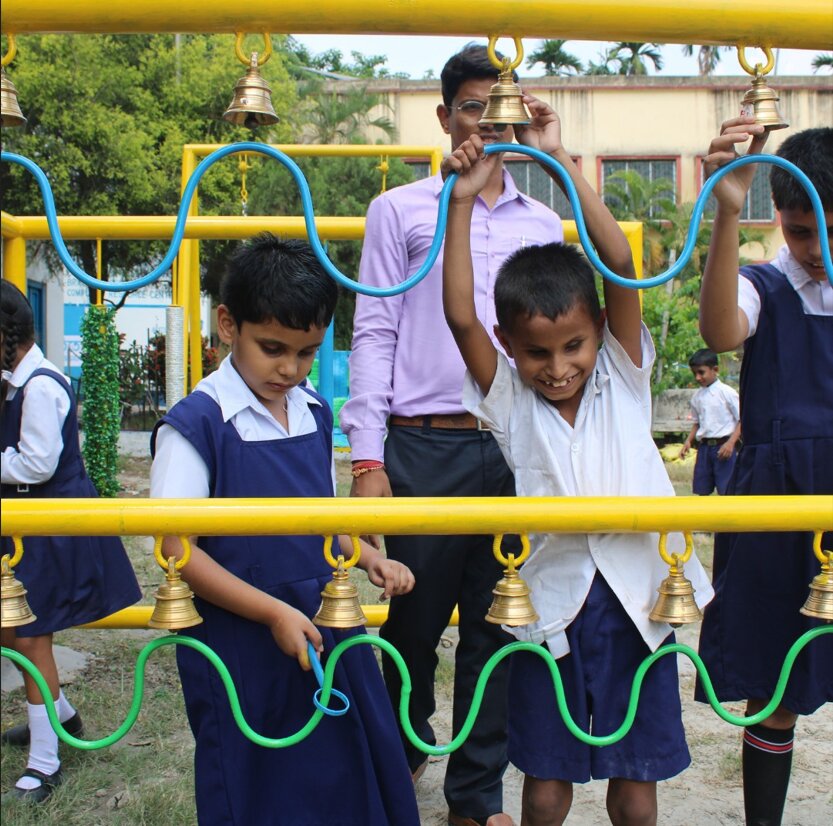
Building ‘community champions’
What Anthill has learnt over the years is that it’s better to involve the community early in the process right from the site selection to what they are designing. When they involve the community from the beginning, they take greater ownership of the playgrounds. Typically, what Anthill does is build a playground, and hands it over to the community to take care of it.
But how do they obtain community buy-in for these playgrounds? “When we work in a new geography, there’s always a local organisation or NGO who might have been working in these communities for years and already have that relationship built with them. When they bring us in, there is that sense of respect and trust already established when we go in. On our end, we also spend time with people explaining to them what structure is going to come up here,” says Rai.
To maintain costs, Anthill largely procures materials locally and employs local labour.
“Given the elements that we’ve designed are simple and basic like tires and metal drums, and engage in recycling and upcycling, it doesn’t make sense to transport things from Bengaluru to Tripura. We procure materials locally because it saves cost, available locally. Where it becomes challenging is to ensure the quality that we want in these elements,” she explains.
“To overcome these concerns, we have a set of vendors in Kolkata, Delhi and Bengaluru, and we transport these joineries from one central hub to wherever we are building playgrounds. Elements like tires and metal, we procure locally because those are like the bigger bulk of what we kind of use to design these playgrounds. Given we have now built playgrounds in 22 different states, we have identified vendors and all of these communities,” she adds.
Also, as stated earlier, Anthill doesn’t take ownership of the playgrounds they build.
“We are just facilitators who are enabling the local community or the school to build a playground. We bring in funding with the help of a corporation and provide our expertise in how to construct the playground. But after those six days of intervention, our major role is complete in building the playground and we hand it over to the community,” she says.
Whether this handover period is over one or three months, it varies based on where the playground is located. They often complete building the playground in six days.
“On the last day, we do a quality check with the corporate who’s funding the project and the local headmaster, and make sure that the playground we’ve constructed meets all the basic quality measures. And then we proceed towards our adoption plan. We identify one community champion. It could be anyone from a headmaster to a teacher or an alumni of that school, who was involved in building that playground and is happy to volunteer their time. We maintain correspondence with them. After one month, we contact them to do a basic check on how children are playing in these playgrounds. We have a questionnaire that they answer to help us assess the impact of this playground. We get both quantitative and qualitative feedback and whenever we’re building a new play element, we receive some extra feedback,” she explains.

‘Our playgrounds are like IKEA blocks’
Apart from handing their playgrounds over to communities, once a year (or once in two years) Anthill organises a drive where their team travels and conducts checks to ascertain the state of our older playgrounds. Making matters easier, their playgrounds are low-maintenance.
“Since our playgrounds are DIY, we do not refabricate (play elements like) a conventional merry go round. If there’s a screw coming loose, you have to replace the merry go round entirely. Our playgrounds are like IKEA blocks. You can fix them, take them off when you want and put them in another place held together by nuts and bolts,” claims Rai.
To facilitate play for young children, Anthill Creations has come up with a variety of innovations to facilitate greater inclusivity and work within the confines of different circumstances. For example, they came up with the concept of a Play Library. “So, we used smaller tires to create seating spaces in a more interesting way where the entire space felt very inviting for children to play. We had basically converted a library into a play area,” recalls Rai.
However, one of Rai’s favourite innovations in recent years is this concept called ‘Playground on Wheels’ which Anthill has developed. “And this idea honestly came when we were going around finding spaces in Mumbai and Bengaluru on where we can build these playgrounds for schools that contained three or four storeys and nothing else,” she says.
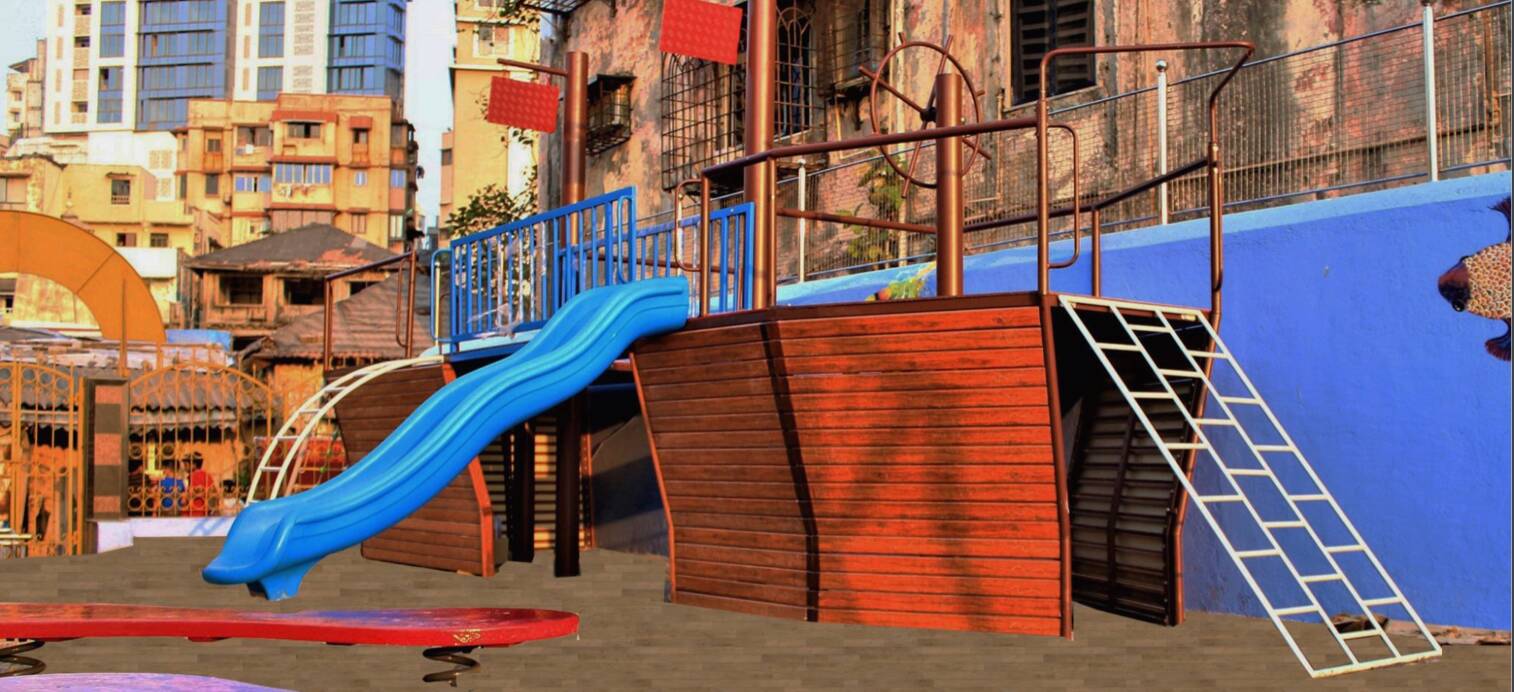
In Mumbai, she recalls a teacher telling her that her students really needed space to play.
“So we came up with this concept of Playground on Wheels, which is basically a truck converted into a playground. It can be shared amongst different neighbourhoods and it can go from one place to another. Once the truck playground arrives at a location and opens up, you’ll find climbers, sandbox and other tactile elements that allow children to play in groups. Whenever the truck arrives, it becomes play time for those children,” she explains.
“It’s a bit like ice cream trucks coming around, but also signifying to children that this is their playtime. In the next couple of months, we will build our first prototype of that truck. We also won an award from the Government of India for designing this Playground on Wheels and hoping it will be implemented very soon,” she adds. If you found our stories insightful, informative, or even just enjoyable, we invite you to consider making a voluntary payment to support the work we do at The Better India. Your contribution helps us continue producing quality content that educates, inspires, and drives positive change. Choose one of the payment options below for your contribution- By paying for the stories you value, you directly contribute to sustaining our efforts focused on making a difference in the world. Together, let’s ensure that impactful stories continue to be told and shared, enriching lives and communities alike. Thank you for your support. Here are some frequently asked questions you might find helpful to know why you are contributing?

Have you come across any innovative ideas or construction executed in playgrounds in your city? We’d love to hear all about it. Send pictures and information about the playground to [email protected] with the subject line “Childhood Dialogues”.
(Edited by Divya Sethu; Images courtesy Anthill Creations)
This story made me
-
97
-
121
-
89
-
167





